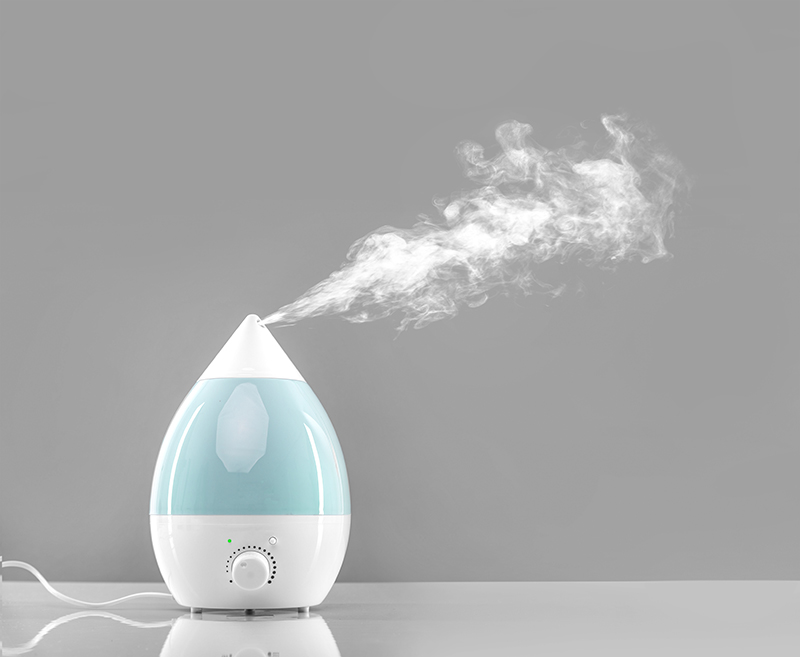Indoor air quality is essential for maintaining optimum health conditions in your home. Controlling the indoor air quality can help reduce airborne illnesses such as the flu, keep skin healthy by retaining its moisture, maintain the life of paint and textiles, and reduce static electricity.
Understanding Humidity Levels
Throughout the year, you will want to maintain humidity levels of around 40-50 in your home. Your geographical location will play a large part in how you accomplish this goal.
Humidity levels tend to rise during the summer. While monitoring your humidity levels year-round is important, you may not need a humidifier during these months. However, winter months cause humidity levels to decrease, and taking advantage of a humidifier during these months is a wise choice.
Types of Humidifiers
There are various types of humidifiers to choose from, including the following:
- Evaporative – The evaporative humidifier uses a wick to draw upon water in a reservoir. The fan blows air over the wick, which causes it to blow out moisturized air. Some favorable aspects of this model are its affordability and less concern about safety risks because it does not use heat. Negative aspects are that this model is louder than the others because of the fan, and the wick can grow mold if not maintained properly.
- Ultrasonic – The ultrasonic humidifier uses an ultrasonic frequency to create droplets of water blown into the air by a fan. Some positive aspects of this model are its ease of maintenance and quiet operation. A negative aspect is that not all models have a demineralized option; therefore, you may want to ensure you purchase one with this option to avoid mineral buildup.
- Impeller – The impeller humidifier breaks down the water with a diffuser, which causes water droplets to enter the air. This model has some positive aspects, such as its affordability and popularity. However, it also has some negative factors, such as noise and regular maintenance.
- Steam vaporizers – The steam vaporizer humidifier uses electricity to heat water. After the water turns into steam, it enters the air. Some positive aspects of this model are its affordability and you don’t have to worry as much about bacteria in the steam. Some negative aspects are that the steam vaporizer uses more energy than other models, and the heated steam must be used with added caution around children.
Choosing the Right Size
To choose the right size for a humidifier in your home, you must decide if you wish for it in one room or in your entire home. Consider the following:
- Small rooms (400 sq. ft.) – Portable and compact humidifiers
- Medium rooms (400 – 1,000 sq. ft.) – Tower humidifiers
- Large rooms (more than 1,000 sq. ft.) – Tower or console humidifiers
- Whole house (3,000 – 4,000 sq. ft.) – In-duct humidifier
Features to Look For
Some essential and optional features to look for when choosing a humidifier include the following:
- Adjustable humidity settings
- Mist output settings
- Noise level
- Automatic shut off
- Medicine cup
- Dishwasher-safe tank
- Tank capacity
- Filter sensor
Maintenance and Safety Tips
Instructions on how to clean and maintain a humidifier for optimal performance and safety are as follows:
- Unplug the humidifier.
- Empty the water.
- Fill the tank with 1 cup of vinegar and 1 cup of water. Let the vinegar-water solution to sit for an hour.
- Clean the reservoir with a Q-tip dipped in vinegar.
- After an hour, empty the vinegar and water solution from the tank.
- Fill the tank with water and rinse multiple times.
Safety precautions to follow when using a humidifier include the following:
- Be careful around children. This is especially true if you are using heated steam models.
- Ensure proper maintenance so your humidifier does not release harmful airborne bacteria.
- Ensure that your humidity levels stay in the optimum range.
Conclusion
Maintaining air quality in your home is an important decision. A humidifier can help reduce the risk of airborne illnesses, prevent dry and cracking skin, and protect materials in your home, such as paint and textiles.
Thornton Heating and Cooling can help you make an informed decision so that you can control the humidity levels in your home. Contact us today to get the help you need.

